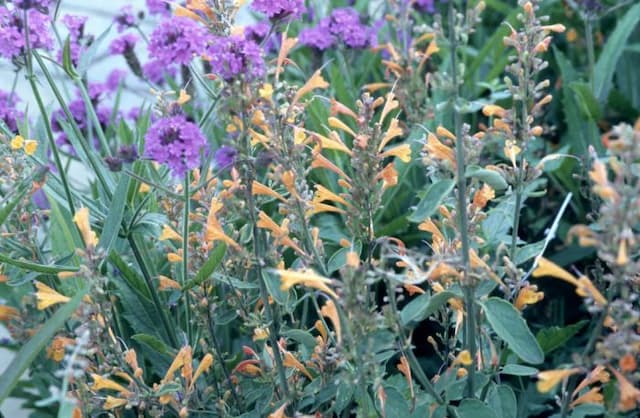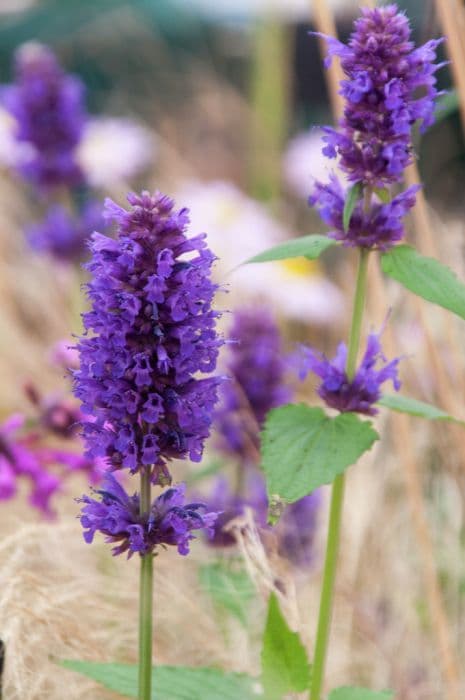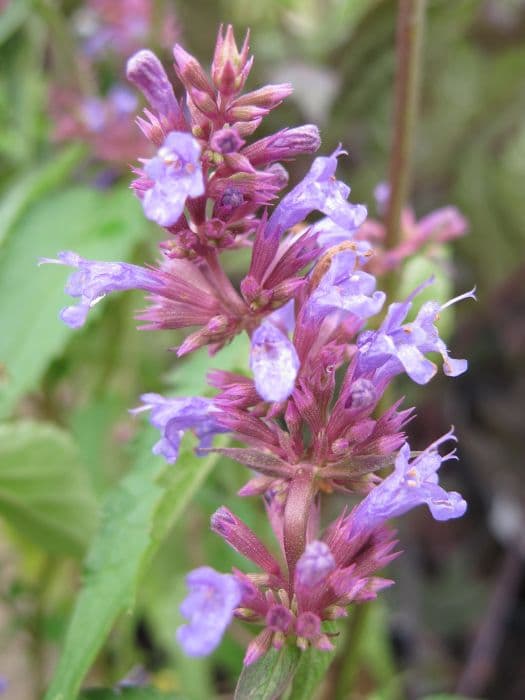French Lavender Lavandula pedunculata subsp. pedunculata

ABOUT
The plant commonly known as French Lavender is recognized for its distinctive appearance, characterized by its aromatic gray-green foliage. The leaves are slender and elongated, typically with a somewhat fuzzy or woolly texture that adds to its charm. What truly sets this plant apart is its striking flower display. The blooms are borne on long stems that rise prominently above the foliage, showcasing dense spikes of small purple flowers. These flowering spikes are adorned with a set of larger, showy bracts at the top, which are typically a lighter shade of purple and sometimes appear almost mauve or pinkish. The bracts are petal-like and give the inflorescence a distinctly elegant and decorative look, which is a signature trait of this particular variety of lavender. The overall shape of the plant is mounding, with the foliage forming a bushy base from which the flower spikes gracefully emerge. The blooms give off a pleasant, sweet fragrance that is widely adored and sought after for use in perfumes, sachets, and various aromatic products. Its scent and appearance make it a favorite in gardens and landscapes where it adds both color and fragrance.
About this plant
 Names
NamesFamily
Lamiaceae.
Synonyms
French Lavender, Butterfly Lavender, Lavandin, Spanish Lavender.
Common names
Lavandula stoechas subsp. pedunculata, Lavandula pedunculata.
 Toxicity
ToxicityTo humans
The plant commonly known as French lavender (Lavandula pedunculata subsp. pedunculata) is generally not considered toxic to humans. It is widely cultivated for its aromatic flowers and oils and is often used in culinary and medicinal applications. However, in rare cases or when consumed in excessive quantities, there might be potential for mild discomfort or an allergic reaction. Any symptoms would likely be minor, such as an upset stomach, but this is not common. Direct contact with the plant's oils could potentially cause skin irritation or an allergic reaction in sensitive individuals. If ingested in large amounts, more severe symptoms such as nausea, vomiting, or diarrhea could occur.
To pets
French lavender (Lavandula pedunculata subsp. pedunculata) is generally considered to be of low toxicity to pets. However, as with any non-food plant, ingestion in significant amounts could potentially cause mild gastrointestinal upset, such as vomiting or diarrhea in some animals. The essential oils present in the plant may also be more problematic if ingested in large quantities or if a pet comes into contact with concentrated oil, potentially leading to more serious symptoms like central nervous system depression or allergic reactions. It is always best to prevent your pets from eating plants that are not intended for their consumption.
 Characteristics
CharacteristicsLife cycle
Perennials
Foliage type
Evergreen
Color of leaves
Gray-green
Flower color
Purple
Height
2 feet [60 cm]
Spread
2 feet [60 cm]
Plant type
Shrub
Hardiness zones
8
Native area
Mediterranean
Benefits
 General Benefits
General Benefits- Aesthetic Appeal: Lavender is prized for its vibrant purple flowers and pleasant fragrance, which can enhance the visual attractiveness and sensory appeal of a garden or landscape.
- Attracts Pollinators: Lavender is known to attract bees, butterflies, and other pollinating insects, which are beneficial for the garden ecosystem and the pollination of other plants.
- Drought Tolerance: Once established, lavender is a hardy plant that can tolerate periods of low water availability, making it suitable for xeriscaping and water-conservation landscaping.
- Low Maintenance: Lavender generally requires minimal care once established, needing little in the way of pruning or fertilization, making it an easy plant to grow for gardeners of all skill levels.
- Fragrance Production: The flowers and foliage of lavender emit a strong, refreshing scent, which can be used in potpourris, sachets, and as a natural air freshener.
- Culinary Uses: Some varieties of lavender are used in cooking and can impart a unique floral flavor to dishes, such as desserts or herbal teas.
- Crafting and Decor: Dried lavender flowers are often used in crafting, such as in making wreaths, arrangements, or decorative bundles.
 Medical Properties
Medical Properties- Antiseptic: Lavender traditionally has been used for its antiseptic properties, which may help in preventing the growth of bacteria and fungi.
- Anxiolytic: Commonly recognized for its calming effect, lavender is used to reduce anxiety and promote relaxation.
- Anti-inflammatory: The plant may offer anti-inflammatory benefits and could be used to ease swelling and irritation.
- Analgesic: As a pain reliever, lavender sometimes finds application in soothing headaches and other mild pains.
- Carminative: Lavender is considered to have carminative effects, which means it may help in reducing gas and bloating.
- Antidepressant: The aroma of lavender is associated with alleviating symptoms of depression and improving mood.
- Sedative: Its sedative properties may aid in improving sleep quality and combating insomnia.
 Air-purifying Qualities
Air-purifying QualitiesThis plant is not specifically known for air purifying qualities.
 Other Uses
Other Uses- Aromatherapy: Lavender essential oil is widely used for relaxation and stress reduction in aromatherapy practices.
- Insect Repellent: The plant can be used to repel mosquitoes and moths due to its strong scent.
- Culinary Uses: Lavender flowers can be used to flavor baked goods, jellies, and other dishes for a unique, floral taste.
- Homemade Cleaning Products: The essential oil can be mixed with vinegar or baking soda to create natural cleaning products with a pleasant scent.
- Textile Dye: Flowers of the lavender plant can be used to create a natural, light purple dye for fabrics.
- Fragrance Sachets: Dried lavender flowers are often placed in small sachets to freshen drawers and closets.
- Garden Design: The plant is used as an ornamental addition to gardens for its aesthetic appeal and to attract pollinators like bees and butterflies.
- Flavoring Honey: Beekeepers sometimes position their beehives near lavender fields to produce lavender-infused honey.
- Companion Planting: Lavender can be planted among other crops to deter pests with its strong scent, benefiting the growth of plants like roses and vegetables.
- Art and Craft: Lavender stems and flowers can be used in floral arrangements, wreaths, or potpourri for decoration.
Interesting Facts
 Feng Shui
Feng ShuiThe French Lavender is not used in Feng Shui practice.
 Zodiac Sign Compitability
Zodiac Sign CompitabilityThe French Lavender is not used in astrology practice.
 Plant Symbolism
Plant Symbolism- Calmness: Lavender is often associated with tranquility and relaxation, which is why it's frequently used in aromatherapy to help ease stress and anxiety.
- Purity: The clean, fresh scent of lavender is symbolic of cleanliness and purity, making it a popular choice for soaps and personal care products.
- Devotion: Lavender can represent a deep and committed love, making it a meaningful gift between partners or family members.
- Healing: Known for its medicinal properties, lavender symbolizes healing and recovery, used in traditional remedies for its soothing effects.
- Protection: Lavender has been used for centuries in different cultures to ward off evil spirits and protect homes, representing safety and security.
- Silence: The name "lavender" is believed to be derived from the Latin word "lavare," meaning to wash or to be quiet, symbolizing silence and peace.
 Water
WaterThe plant, commonly known as French Lavender, requires moderate watering. It's best to allow the top inch of the soil to dry out before watering again. Typically, this means watering approximately once every 1 to 2 weeks, although the frequency depends on the climate and weather conditions. When watering, it's important to water deeply, using enough water to reach the roots. An estimated amount of water might be 1 to 2 gallons for an outdoor plant every couple of weeks in dry conditions, adjusting based on rainfall and temperature.
 Light
LightFrench Lavender prefers full sun conditions, meaning it thrives in a spot that receives at least 6 to 8 hours of direct sunlight daily. An ideal location would be a south-facing garden or a window that gets ample sunlight throughout the day. Ensure this plant isn't placed in excessive shade, as this can affect its growth and blooming.
 Temperature
TemperatureFrench Lavender flourishes best in temperatures between 60 and 70 degrees Fahrenheit. The plant can survive temperatures as low as 10 degrees Fahrenheit but may suffer damage at these extremes. During extreme heat, ensure the plant has adequate water but avoid over-watering.
 Pruning
PruningPrune French Lavender to encourage bushy growth and prevent it from becoming woody. The best time to prune is in the spring after the last frost or in the early fall. Remove spent flowers and about a third of the current year's growth to maintain shape and promote more blooms. Pruning should be done at least once a year.
 Cleaning
CleaningAs needed
 Soil
SoilFrench Lavender thrives in well-draining, sandy, or gravely soil mixed with compost or organic matter. The best soil mix can be made by combining two parts coarse sand, one part perlite or pumice, and one part compost. The soil pH should be slightly alkaline, ranging between 6.5 and 8.0.
 Repotting
RepottingFrench Lavender should be repotted every 2 to 3 years to refresh the soil and accommodate root growth. It is best to repot in spring just before the new growth starts.
 Humidity & Misting
Humidity & MistingFrench Lavender prefers low to moderate humidity levels. Excessive humidity can lead to fungal diseases, so it's important to ensure good air circulation around the plant.
 Suitable locations
Suitable locationsIndoor
Place French Lavender near a sunny window and ensure good air flow.
Outdoor
Plant French Lavender in full sun and well-drained soil.
Hardiness zone
7-9 USDA
 Life cycle
Life cycleFrench Lavender (Lavandula pedunculata subsp. pedunculata) starts its life cycle as a seed, requiring well-drained soil and sunlight to germinate. Upon germination, the seedling grows into a young plant, developing a deep root system and foliage. The plant reaches maturity when it starts to produce characteristic fragrant purple flowers, usually in late spring to early summer. After pollination, often by bees and butterflies, the flowers produce seeds which can be dispersed to propagate new plants. Throughout the growing season, this perennial will continue to grow foliage and may bloom repeatedly. In autumn, growth slows, and the plant enters a dormant phase during cold winter months, but it does not die back completely and will resume growth as temperatures rise in spring.
 Propogation
PropogationPropogation time
Spring to early summer
The most popular method of propagating French lavender (Lavandula pedunculata subsp. pedunculata) is through semi-hardwood cuttings. This is typically done in late summer. Cuttings should be about 3-4 inches (7.6-10 cm) long and taken from healthy, non-flowering stems. Remove the lower leaves, dip the cut end in rooting hormone, and insert the cutting into a well-draining soil mix. It's crucial to maintain high humidity around the cuttings for the first few weeks, which can be achieved by covering them with a plastic bag or placing them in a propagator. Keep the soil moist but not waterlogged, and within a few weeks, the cuttings should root and can be potted on or planted out.







![Bugle [Black Scallop]](/_next/image?url=https%3A%2F%2Fplants-admin.emdemapps.com%2Fimages%2Fplants%2F%2Fimages%2F604b624330cd1.png&w=640&q=75)

